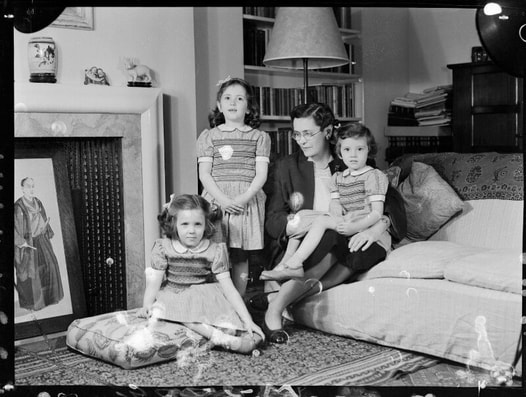CECILIA LADY SEMPILL (d 1984)
 Hon. Kirstine Elizabeth de Daranyi (née Forbes-Sempill); Hon. Janet Cecilia Forbes-Sempill; Cecilia Alice (née Dunbar-Kilburn), Lady Sempill; Hon. Brigid Gabriel Menuhin (née Forbes-Sempill). Photograph by Navana Vandyk (quarter-plate film negative, 19 June 1949; NPG x98007).
Hon. Kirstine Elizabeth de Daranyi (née Forbes-Sempill); Hon. Janet Cecilia Forbes-Sempill; Cecilia Alice (née Dunbar-Kilburn), Lady Sempill; Hon. Brigid Gabriel Menuhin (née Forbes-Sempill). Photograph by Navana Vandyk (quarter-plate film negative, 19 June 1949; NPG x98007).
Cecilia Alice (nee Dunbar-Kilburn), Lady Sempill, (died 1984), was the second wife of 19th Lord Sempill, of Craigievar Castle.
A visit to Craigievar could reveal more than you thought. You might be forgiven for expecting to see turrets, gargoyles and armour – all of which you will – but you might not expect to see a large collection of decidedly mid-20th century Modernist ceramics from some of the most respected makers of their day.
Mid Century Modernism in a Scottish Tower House
There are also examples of other decorative arts which illustrate the informed yet somewhat unexpected tastes of the wife of a laird living in a Scottish castle.
The reason for this is that Cecilia Dunbar-Kilburn was the second wife of the 19th Lord Sempill, whom he married in 1941. William’s first wife, Eileen, was the daughter of renowned artist, Sir John Lavery, whose work is present at Aberdeen Art Gallery in the well-known painting The Tennis Party.
Cecilia was no slouch in the artistic department. She trained as an artist at the Royal College of Art and studied sculpture; Henry Moore was her contemporary in the year above. Her wide circle of artistic friends included Eric Ravilious and Edward Bawden (whose pen and ink drawing of Craigievar hangs in the Nursery).
Cecilia would open the shop ‘Dunbar Hay Ltd’ of 15 Albemarle Street, London W1. It was founded in 1936 with Athole Hay and gave opportunities for graphic artists and students from the Royal College of Art. These included Ravilious, and Bawden and Enid Marx. It enabled them to show their designs, including furniture, furnishings, ceramics and fabrics. Ravilious designed the wood-engraved trade card for the shop, which closed in 1941 during the ongoing Blitz.
In 1947 Cecilia would publish a monograph on English pottery and porcelain as part of the Britain in Pictures series of books, designed to boost morale and record the (then) British way of life. These books were slim volumes with distinctive elegant covers. She was perhaps asked to write her monograph because of her wide knowledge of ceramics; Dunbar Hay had given her a practical knowledge of their design and commercial production.
The rise of the studio potter had been the principal design event of her own lifetime and one which she fully embraced. She knew many of the leading potters personally. Whilst the Forbes-Sempill family could be expected to have inherited many examples of fine historic ceramics, the visitor might be surprised to see some near contemporary pieces all around the castle.
Graham Sutherland’s association with Cecilia goes far back to when she and Athole Hay “ran the shop”. Sutherland, along with darlings of the Bloomsbury set such as Vanessa Bell, was commissioned by Foley China to design pieces for a show to be staged at Harrod’s. As Cecilia was to observe: “His green-spot design was a best seller” and was stocked at Dunbar Hay Ltd.
There is a series of wax papers designed by Cecilia for Dunbar-Hay which were used at Craigievar as drawer liners. There are also textiles which are examples of the simple printed Indian cottons favoured in Cecilia’s interiors at Craigievar and were considered ‘artistic’ at the time. Much in the same vein were the seed pod vessel and the horn beaker and spoons whose rustically natural appearance of form were often appropriated in direct opposition to the stark and angular forms of the post-War period.
Cecilia certainly bucked the trend when it came to the general perception of a Laird’s wife in Aberdeenshire in the last century. She brought her artistic tendencies and her trained eye, as well as her notable friends in the art world, to a fortified castle on Donside which can still be seen in situ.
Entry written by Vikki Duncan, National Trust for Scotland.
A visit to Craigievar could reveal more than you thought. You might be forgiven for expecting to see turrets, gargoyles and armour – all of which you will – but you might not expect to see a large collection of decidedly mid-20th century Modernist ceramics from some of the most respected makers of their day.
Mid Century Modernism in a Scottish Tower House
There are also examples of other decorative arts which illustrate the informed yet somewhat unexpected tastes of the wife of a laird living in a Scottish castle.
The reason for this is that Cecilia Dunbar-Kilburn was the second wife of the 19th Lord Sempill, whom he married in 1941. William’s first wife, Eileen, was the daughter of renowned artist, Sir John Lavery, whose work is present at Aberdeen Art Gallery in the well-known painting The Tennis Party.
Cecilia was no slouch in the artistic department. She trained as an artist at the Royal College of Art and studied sculpture; Henry Moore was her contemporary in the year above. Her wide circle of artistic friends included Eric Ravilious and Edward Bawden (whose pen and ink drawing of Craigievar hangs in the Nursery).
Cecilia would open the shop ‘Dunbar Hay Ltd’ of 15 Albemarle Street, London W1. It was founded in 1936 with Athole Hay and gave opportunities for graphic artists and students from the Royal College of Art. These included Ravilious, and Bawden and Enid Marx. It enabled them to show their designs, including furniture, furnishings, ceramics and fabrics. Ravilious designed the wood-engraved trade card for the shop, which closed in 1941 during the ongoing Blitz.
In 1947 Cecilia would publish a monograph on English pottery and porcelain as part of the Britain in Pictures series of books, designed to boost morale and record the (then) British way of life. These books were slim volumes with distinctive elegant covers. She was perhaps asked to write her monograph because of her wide knowledge of ceramics; Dunbar Hay had given her a practical knowledge of their design and commercial production.
The rise of the studio potter had been the principal design event of her own lifetime and one which she fully embraced. She knew many of the leading potters personally. Whilst the Forbes-Sempill family could be expected to have inherited many examples of fine historic ceramics, the visitor might be surprised to see some near contemporary pieces all around the castle.
Graham Sutherland’s association with Cecilia goes far back to when she and Athole Hay “ran the shop”. Sutherland, along with darlings of the Bloomsbury set such as Vanessa Bell, was commissioned by Foley China to design pieces for a show to be staged at Harrod’s. As Cecilia was to observe: “His green-spot design was a best seller” and was stocked at Dunbar Hay Ltd.
There is a series of wax papers designed by Cecilia for Dunbar-Hay which were used at Craigievar as drawer liners. There are also textiles which are examples of the simple printed Indian cottons favoured in Cecilia’s interiors at Craigievar and were considered ‘artistic’ at the time. Much in the same vein were the seed pod vessel and the horn beaker and spoons whose rustically natural appearance of form were often appropriated in direct opposition to the stark and angular forms of the post-War period.
Cecilia certainly bucked the trend when it came to the general perception of a Laird’s wife in Aberdeenshire in the last century. She brought her artistic tendencies and her trained eye, as well as her notable friends in the art world, to a fortified castle on Donside which can still be seen in situ.
Entry written by Vikki Duncan, National Trust for Scotland.



